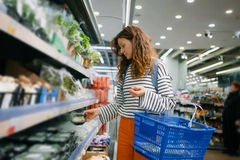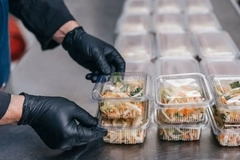Sealpac develops recyclable sliced meats cardboard carrier in EU recycling boost

21 Jun 2021 --- Sealpac has developed a recyclable, reclosable meat packaging solution called FlatMap for Swiss meat manufacturer Bigler’s charcuterie business unit.
Designed for sliced meats, the FSC-certified cardboard carrier is sealed with a transparent top film that uses 60-70 percent less plastic than conventional modified atmosphere packaging (MAP) trays, according to Sealpac.
“The FlatMap pack contains just 110 microns of plastic. The liner is only 40 microns thick, whereas the reclosable top film has a thickness of just 70 microns,” Marcel Veenstra, marketing manager at Sealpac, tells PackagingInsights.
“This is significantly lower than common plastic packaging, which will contain around 400-450 micron of plastic.”
The flat carrier is also easily separated from its plastic film counterpart, which facilitates recyclability and meets 2030 EU recycling requirements. The plastic film’s tight fit further prevents meat discoloration, contamination and food waste.
The EU aims to ensure 50 percent of all plastic packaging is recycled by 2025 and 55 percent by 2030. Moreover, all packaging should be recyclable or reusable in an economically viable way by 2030.
“The idea for FlatMap came at the exact right time. It became our joint goal to combine characteristics such as product protection, high barriers, recyclability, low packaging weight and reclosability in one of the most sustainable packaging solutions on the market,” says Bigler CEO Markus Bigler.
.png) Sealpac says the reclosable FlatMap is made with 70% less plastic than conventional MAP solutions.Sealpac created the carrier together with its Van Genechten Packaging and film partner Buergofol. The project was presented to Bigler AG in Switzerland, which had already used a Sealpac FlatSkin cardboard carrier.
Sealpac says the reclosable FlatMap is made with 70% less plastic than conventional MAP solutions.Sealpac created the carrier together with its Van Genechten Packaging and film partner Buergofol. The project was presented to Bigler AG in Switzerland, which had already used a Sealpac FlatSkin cardboard carrier.
R&D challenges in sliced meat
Sealpac identified from customer projects that similar solutions are also sought for MAP. The technology substitutes the atmospheric air inside a package with a protective gas mix, which helps ensure the product stays fresh for as long as possible.
Instead of using the gas mix, the FlatMap carriers rely on a thin polyolefin-based plastic layer, which provides a reliable barrier against moisture, fat and oxygen.
Notably, Buergofol was faced with the challenging task of developing a liner that adheres well to the cardboard but can still be easily separated later for recycling purposes. However, the plastic should not come off entirely before the consumer has finished consuming the product.
According to a 2021 Innova Market Insights consumer survey, 51 percent of global deli meat consumers regard food safety as an important packaging consideration, followed by product storage (50%).
Using less paper
Overall, Buergofol had to make sure the thickness of both liner and top film was reduced to a minimum. Another food safety challenge related to chilled products’ sensitivity to moisture. To rule out microbial risks, Van Genechten Packaging only uses virgin fibers.
“At the moment, virgin fibers are necessary to get approval for any paper-based packaging to be used for direct food contact,” Veenstra explains.
“However, virgin fibers have an additional benefit, as they make the pack more sturdy. As a result, we can use thinner boards, which means we use significantly less paper overall.”
.png) The Sealpac A7 traysealer produces FlatMap packaging at Bigler’s facility.
The Sealpac A7 traysealer produces FlatMap packaging at Bigler’s facility.
Attractive in the aisles
Arriving on supermarket shelves, FlatMap offers significant space for communication and branding on-pack. “The cardboard carrier can be attractively printed on both sides and used for various types of information,” says Vittorio Ranaldo, head of marketing and communications at Bigler.
The Innova Market Insights survey revealed global deli meat consumers also value product information (38%) and product promotion (10%) as important packaging concerns.
“Presented standing, hanging or lying down, it is always a real eye-catcher thanks to its entirely new look and full visibility of the product,” Bigler adds.
Meat packaging developments
Outside of MAP and flat carriers, the meat packaging industry ranges from automatic vacuum-wrapping machines to mono-material PET films and post-consumer recycled plastic meat casings.
This year, Coveris developed a recyclable envelope-style cartonboard pack for private-label fish, while Wipak and Woodly replaced fossil-based plastics in meat packaging with renewable plastic made from wood cellulose. In January, an EU-funded project developed bio-based active packaging systems for fresh chicken meat.
PackagingInsights has previously interviewed Sealpac representatives about the German packaging manufacturer’s expertise in plastic punnets for fruits and vegetables.
By Anni Schleicher











